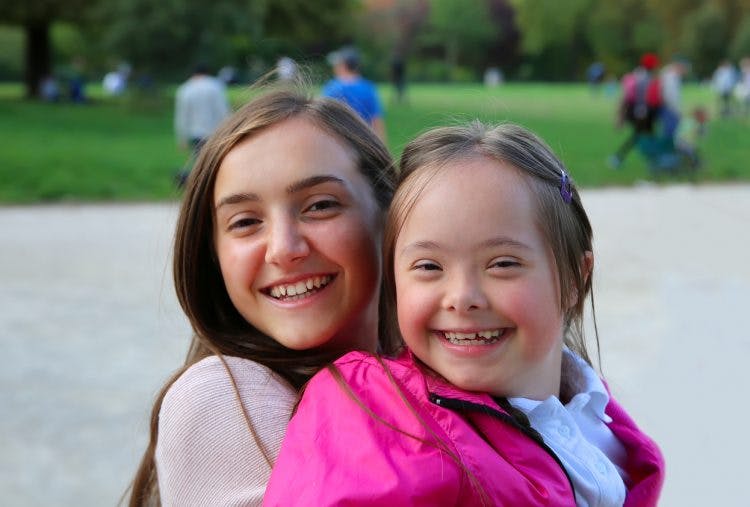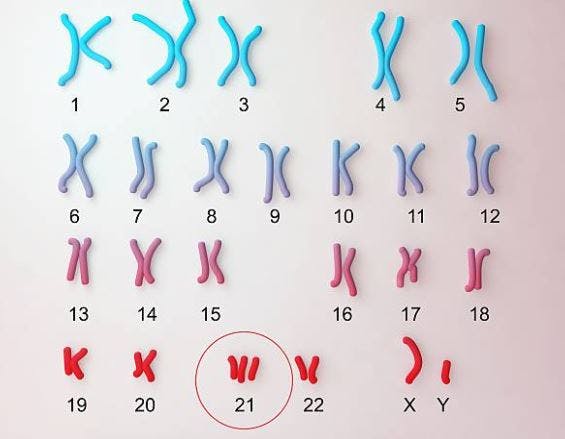No products in the cart.
No products in the cart.
No products in the cart.
No products in the cart.
Home » Neurological Recovery Blog » Cerebral Palsy » Cerebral Palsy and Down Syndrome: Comparing Causes, Effects, and Management
Last updated on January 3, 2020

Cerebral palsy and Down syndrome are two very different conditions that both occur very early in life. Although rare, it’s even possible to have both conditions.
This article is going to compare cerebral palsy and Down syndrome so that you can better understand the distinctions between the two developmental disabilities.
Let’s get started!

When a person is born with an extra chromosome 21, they have Down syndrome. Most people are born with 46 chromosomes, but people with Down syndrome have 47.
This extra chromosome affects physical and cognitive development.
Cerebral palsy is a neurological disorder, and Down syndrome is a genetic condition. CP is caused by damage to the brain before, during, or shortly after birth while Down syndrome is caused by abnormal cell division.
While external forces (trauma to the head, labor complications, etc.) can cause cerebral palsy, Down syndrome is strictly determined by genetics.
Intellectual disabilities are a common associative condition of cerebral palsy, but they are not directly related to CP.
Cerebral palsy is strictly a motor disability, meaning that it only directly affects movement.
The prevalence of intellectual disabilities in people with cerebral palsy is about 50%.
In contrast, everyone who has Down syndrome will have some extent of intellectual disability.
Most people with Down syndrome have mild to moderate intellectual disabilities and are very capable of living productively and purposefully.
Because of intellectual disabilities, infants and children with Down syndrome often have developmental delays when it comes to skills like walking and talking.
This does not mean they are incapable of learning; they just need more time to do so.

People with Down syndrome often share physical features like:
However, it’s important to understand that everyone experiences Down syndrome differently. Individuals can have all, some, or none of these features.
Unlike Down syndrome, cerebral palsy doesn’t necessarily cause distinct physical features.
It predominantly affects muscle tone. Up to 80% of individuals with cerebral palsy experience high muscle tone (hypertonia), while the remaining 20% experience low muscle tone (hypotonia) or fluctuations between the two.
Therefore, individuals with cerebral palsy may walk with an abnormal gait, have poor posture, difficulties with balance and coordination, or be unable to walk altogether.
In the United States, about 1 in every 700 babies is born with Down syndrome, and 2-3 in every 1000 births result in cerebral palsy.
The chances of giving birth to a child with cerebral palsy or Down syndrome are increased in women over 35 years old.
However, it should be noted that just because you’re under 35 does not mean you won’t give birth to a child with Down syndrome or cerebral palsy.
Nearly 80% of infants with Down syndrome are born by women under 35, simply because more women under 35 get pregnant.

Commonly experienced health problems in children with Down syndrome include hearing impairments, vision problems, sleep apnea, and heart defects.
Hearing impairments, vision problems, and sleep apnea are also common associative conditions of cerebral palsy.
While life expectancy is generally unaffected by cerebral palsy, individuals with Down syndrome have a life expectancy of about 60 years.
Additionally, it’s suggested that about 50% of people with Down syndrome develop dementia as they age.
Both cerebral palsy and Down syndrome are lifelong conditions that can be effectively managed to promote an active and fulfilling life.
Because both conditions affect individuals so early in life, seeking early management will ensure that children get the right support for their physical and cognitive needs.
Cerebral palsy and Down syndrome can both cause abnormal muscle tone.
At physical therapy, a child with Down syndrome may work on increasing muscle tone by addressing posture and strengthening. A child with cerebral palsy may also work on developing muscle tone, but more likely would be working on managing high muscle tone (spasticity) through stretching or use of orthoses.
For children with either cerebral palsy or Down syndrome, physical therapy will focus on regulating muscle tone for optimal functioning and improving mobility.
At occupational therapy, your child will learn how to be independent in activities of daily living like brushing their teeth, getting dressed, and eating.
Practicing everyday tasks will also improve mobility and self-confidence.
Occupational therapists also address fine motor coordination, which is commonly limited in children with Down syndrome and potentially those with cerebral palsy as well.

Because of cognitive delays, many children with Down syndrome have difficulties learning how to speak and use language.
Children with cerebral palsy may not be able to control their oral muscles due to high muscle tone.
Additionally, associated problems like hearing and vision impairments can make it even more challenging to communicate with others.
Speech therapy can help teach your child how to effectively communicate by improving speech clarity, building vocabulary, or exploring alternative forms of communication like sign language or communication boards.
Cerebral palsy is a motor disability caused by damage to the brain that may co-occur with intellectual disabilities.
Down syndrome is the result of having an additional chromosome 21 which affects both physical and cognitive development.
While cerebral palsy and Down syndrome share some similarities, they are two very different conditions.
Hopefully, this article helped you understand the distinctions between two!

Get our free 19-page PDF full of helpful tips for cerebral palsy by signing up below! If you liked this article, you’ll LOVE our free ebook.
When you sign up, you’ll also receive our popular emails that share more tips for life with cerebral palsy — you can opt out anytime.
We will never sell your email address, and we never spam. That we promise.


At Flint Rehab, we understand that doing physical therapy at home can become tedious and repetitive. But when repetition is critical to recovery, it’s important to stick with a repetitive regimen. But that doesn’t mean it has to be boring.
Flint Rehab is the leading manufacturer of motion-sensing, gamified rehabilitation devices. Our bestselling recovery tool, FitMi, transforms full-body rehab exercises into an interactive experience.
See what individuals with CP are saying about FitMi:
“The FitMi and MusicGlove have done wonders for my son with hemiparesis from cerebral palsy and stroke. It motivates him to do his exercises. It does not seem like therapy for him since it is fun. FitMi monitors his progress so it is a great reinforcement for him. Music is a motivator for him. He has been using it on his arm and we will try the leg exercises soon.”
-Manning
While FitMi is a recovery tool for the full-body, our other device, MusicGlove, helps target the hand to improve fine motor skills and dexterity.
See what others have said about MusicGlove:
“My granddaughter has right-side hemiplegia from Cerebral Palsy / stroke at birth. She states that this is a great product for anyone who has issues with the use of their hand(s), and that is has helped her tremendously. She also finds the music quite catchy (surprisingly!). Our occupational therapist has been impressed as well. I can say that it has arguably been the best tool of all our therapy resources.”
-Jenni
Together, FitMi and MusicGlove make a powerful home therapy regimen for individuals with cerebral palsy. Best of all, you can save money when you bundle them together.
To learn more, click the button below:

Do you have these 19 pages of helpful tips for CP?
Get a free copy of our ebook Helpful Tips for Managing Cerebral Palsy. Click here to get instant access.
Grab a free rehab exercise ebook!
Sign up to receive a free PDF ebook with recovery exercises for stroke, traumatic brain injury, or spinal cord injury below: